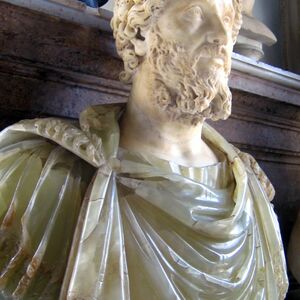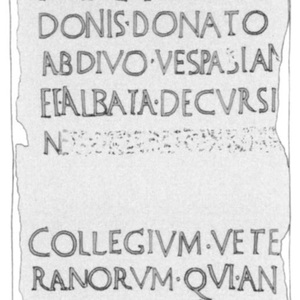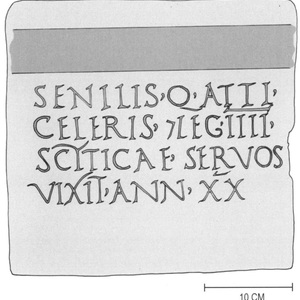Roman Legion - Legio IIII Scythica
Legio IIII Scythica (Fourth Scythian Legion) was a Roman legion formed by Mark Antony, presumably to take part in the war against the Parthians.
Legion name Legio IIII Scythica (Fourth Scythian Legion)
Date of existence: 42 BC. The Legion lasted until the 5th century.
Symbol: image of capricorn
Nickname: Scythica (Scythian). Later-Antoninov.
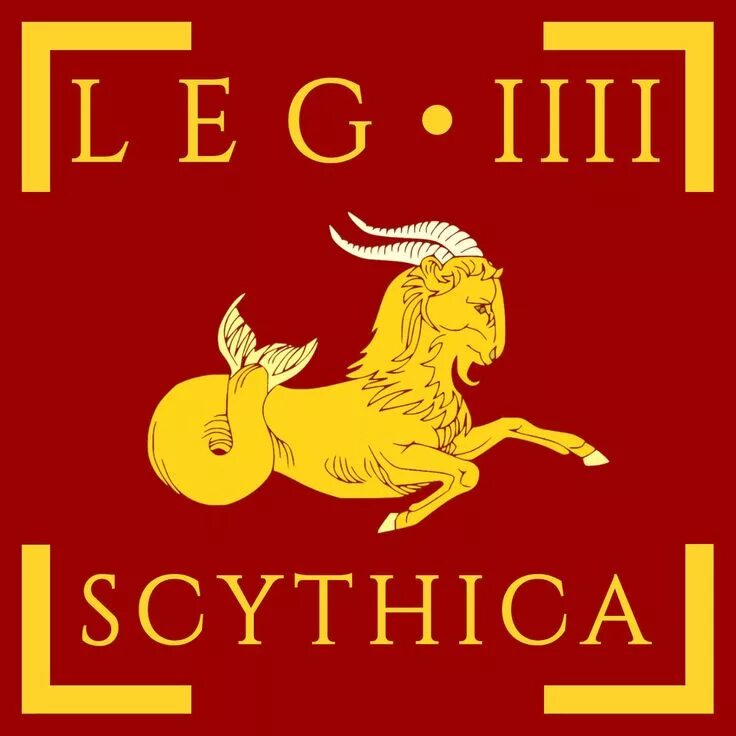
Battle Path
Footing
The IIII Scythian Legion was most likely founded by a triumvir By Mark Antony in the period after 42 BC, it is currently unknown where it was first placed. It has been suggested that the IIII Scythian Legion was stationed in Syria, and if this is correct, then it is likely that it took part in Mark Antony's ill-fated campaign against the Parthian kingdom.
In 31 BC, he was the adopted son of Gaius Julius Caesar Octavian he defeated Mark Antony in the naval battle of Cape Actium. In 30 BC, the defeated triumvir committed suicide. From now on, the Roman Empire was ruled by one man, Octavian, who after a while took the name of Augustus. It is obvious that after these events the IIII Scythian Legion entered the service of Octavian.
The reign of the Julius-Claudians
Apparently, Octavian relocated the legion to Moesia, a region located in the lower reaches of the Danube. The base of the IIII Scythian Legion was located in the town of Viminatsium (near modern Kostolac, Serbia).
In 29-27 BC, the IIII Legion, together with V Macedonian he fought under the command of the Macedonian Proconsul Marcus Licinius Crassus (grandson of the triumvir of the same name) against the Bastarnae, taking part in the most difficult battles. The term" Scythians "at that time referred to all the barbarian peoples living in the territory of South-Eastern Europe, so, most likely, the IIII Legion received the nickname" Scythian " during this period.
From 6 to 9 AD, the IIII Scythian Legion was part of an army of 15 legions, which accounted for more than half of the total military capacity of the Romans at the time under review. This army, under the command of Tiberius, participated in the suppression of revolts in Pannonia and Illyria.
It is possible that the IIII Scythian Legion was the same unit that is reported to have been transported in 12 AD under the command of Legate Vitellius on ships along the Danube to Aegis (modern Tulcea, Romania). The IIII Scythian and V Macedonian Legions often operated together and probably formed a garrison in the province of Moesia in AD 23. In his youth, the future emperor Vespasian served for about 27 years as a military tribune in one of these legions, most likely in the IIII Scythian, and may have participated in the suppression of a revolt in Thrace.
The Legion also took on a number of civilian tasks, such as building and maintaining roads for the development of the region. Several stone inscriptions confirm the construction of roads and other engineering works in the Danube region. In 33/34, the IIII Scythian and V Macedonian Legions built an excellent road along the Danube in Upper Moesia. An Athenian inscription mentioning both legions dates back to the same period.
Around the middle of the first century, perhaps as early as the reign of the Emperor Tiberius (14-37) or Claudius (41-54), or perhaps only under Nero (54-68) in 57/58, the IIII Scythian Legion changed its location and went east. The first city where the legion was encamped is considered to be the Syrian city of Kirr, after which it was based in Zeugma on the Euphrates coast for the next two hundred years.
In 66, the governor of Syria, Gaius Cestius Gallus, led an army of XII Lightning Legion commanded by his legate Caesennius Gallus, VI of the Iron Legion and Vexillatii IIII Scythian (whose number numbered 2 thousand people), as well as numerous auxiliary troops, marched from Antioch to suppress the outbreak of the Jewish uprising, which later turned into the First Jewish War. The inhabitants of many villages lying in the way of the army, who did not have time to escape, were killed by the Romans. Cestius Gallus then attacked Jerusalem, but was forced to lift the siege, and suffered heavy losses in his hasty retreat. This defeat also dealt a blow to the reputation of the IIII Scythian Legion. Beginning in 66, the Legion was stationed at Zeugma on the Euphrates coast on the Roman-Parthian border.
By the end of the 60s, the IIII Scythian Legion was the only legion that guarded Syria: from 67 to 69 X Protecting the Strait and the XII Lightning Legions were engaged in suppressing the Jewish revolt, the III Gallic in 67/68 was transferred to the Lower Danube to stop local unrest, and the VI Iron took part in the civil war in 69.
The Flavian period
During the civil war of 69, which broke out as a result of Nero's suicide, the IIII Scythian Legion was on Vespasian's side from day one. Despite the demonstrated loyalty, the legion was not involved in combat operations, as its combat power was not highly appreciated, because just three years earlier it, along with the VI Iron and XII Lightning Legion, had been defeated by the Jews. In 70, the IIII Scythian Legion participated in the suppression of the pogrom in Antioch.
About 75 years of vexillation XVI Flavius the Powerful The III Gallic, VI Iron and IIII Scythian Legions were used for the construction of the canal and bridge in Antioch. Among the most famous officers of the IIII Scythian Legion of this period was the legate Tiberius Julius Celsus Polemeanus, to whom the famous library at Ephesus was dedicated.
Antonine rule period
Despite its tarnished reputation, the IIII Scythian Legion took part in Trajan's campaign against the Parthians (114-117). In the conquered Armenia, the city of Artaxata was fortified by soldiers of the IIII Scythian Legion.
Around the year 149 of the promissory note XVI Flavieva The IIII and IIII Scythian Legions were also used to build a canal in Seleucia-in-Pieria. Another vexillation of the IIII Scythian Legion in the II century was located at the quarries of Enesh on the Euphrates. Inscriptions mentioning the legion are mostly found in the northern part of the province of Syria, but their correlation with historical events and temporary identification, as a rule, is not possible.
Due to the fact that the base of the IIII Scythian Legion, the city of Zeugma, was located on the border between the Roman and Parthian states, we can be sure that it took part in all the wars between the two empires. The next major campaign, where the soldiers of IIII Scythian participated, was the Parthian campaign of Lucius Verus (161-166). During this conflict, the Romans took over most of Mesopotamia and occupied the Parthian capital of Ctesiphon.
Between 181 and 183, in the reign of Commodus (and perhaps even under Marcus Aurelius), the future emperor was the legate of the legion Septimius Severus.
Northern rule period
During another civil war in 193, the IIII Scythian Legion sided with the Syrian governor Pescennius Niger.
In 194, the new emperor Septimius Severus, who defeated Pescennius Niger (who died after the defeat), used the fact that they supported his rival as a pretext for a campaign against the Parthians. During the new eastern campaign, the kingdoms of Adiabene and Osroene came under Roman control. The IIII Scythian Legion undoubtedly took part in military operations. In addition, in the same year, by order of Septimius Severus, the new province of Kelesiriya (Syria Coele) was allocated, which included the northern part of the former province of Syria. The IIII Scythian Legion formed the garrison of the new province.
In 197, the vexillations of the IIII Scythian Legion built the fortress of Eski Hisar in Osroen. In 197-198, the IIII Scythian Legion was part of the Roman army that participated in the second campaign against Parthia. The Roman offensive met with no significant resistance: the Parthian capital of Ctesiphon was stormed, probably in late 197 or early 198. Apparently, the soldiers of the IIII Scythian Legion took part in the capture of Ctesiphon. The Parthian king Vologases IV escaped and, according to Dion Cassius, 100,000 people were taken prisoner by the Romans. Victories in the East were commemorated on the Arc de Triomphe of Septimius Severus.
Several bridges in Northern Syria were built by IIII Scythian legionaries around the year 200. Promissory notes XVI Flavius the Powerful Both the IIII Scythian Legions were under the general command of Centurion Antonius Valentinus in the fortress of Dura Europos around 210, where they repaired the sanctuary of Mithras. During the reign of Emperor Caracalla (officially named Marcus Aurelius Severus Antoninus), the IIII Scythian Legion received the nickname "Antoninov". To Dura-Europos by legionnaires III of Cyrenaica and the IIII Scythian Legions until 216, an amphitheater was built. Perhaps the IIII Scythian Legion participated in the Parthian campaign of Caracalla.
In 219, Gellius Maximus, legate of the IIII Scythian Legion, proclaimed himself emperor, but was soon executed by the Emperor Heliogabalus.
Period of the reign of the soldier emperors and the dominat
In 252 CE, Zeugma was completely destroyed by the Persian army. However, at least until 254, units of the IIII Scythian Legion, which also received the honorary nicknames "Valerian" and "Gallienus", continued to be located in Zeugma. The" local vexillation " of the Legion is mentioned in Dura Europos in 254, and in the divorce documents of legionnaire Julius Antiochus and Aurelia Ammima. Vexillation probably took part in the siege of the city by the Sassanids in 254-257. It is assumed that the IIII Scythian Legion participated in all the Roman-Persian wars in the III century, including the Persian campaigns of the Palmyra king and corrector of the East Lucius Septimius Odenathus.
The division of the IIII Scythian Legion was transferred, presumably, during the reign of Diocletian (284-305) to Oresu (modern Taiba, Israel), while most of its personnel remained elsewhere as garrisons. At the beginning of the 5th century, the Scythian Legion was last mentioned in the sources. According to the Notitia Dignitatum, he was under the command of duxa He was stationed with his prefect in Ores.
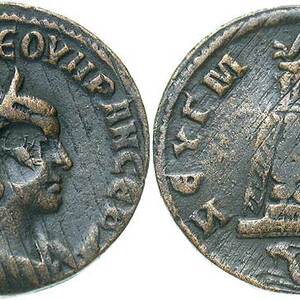 Coin of the Emperor Philip the Arab with a portrait of his wife Marcia Otacilia Severus. On the reverse are depicted: capricorn, the symbol of the IIII Scythian Legion and the garrison temple in Zeugma
Coin of the Emperor Philip the Arab with a portrait of his wife Marcia Otacilia Severus. On the reverse are depicted: capricorn, the symbol of the IIII Scythian Legion and the garrison temple in ZeugmaRelated topics
List of Roman Legions, legion, legionnaire, XVI Flavius, Septimius Severus, Notification Dignitatum
Literature
The Roman military base at Dura-Europos, Syria. Simon James. Oxford University Press, 2019
Emil Ritterling. Paulys Realencyclopädie der classischen Altertumswissenschaft. Legio (IIII Scythica). Band XII,2. — Stuttgart, 1925. — 1556—1564 p.
Fergus Millar. The Roman Near East. 31 BC – AD 337. — Cambridge MA: Harvard University Press, 1996.
Lawrence Keppie. The making of the Roman Army. From Republic to Empire. — Norman OK: University of Oklahoma Press, 1998.
Oliver Stoll. Römisches Heer und Gesellschaft. — Stuttgart: Steiner, 2001.
Axel Gebhardt. Imperiale Politik und provinziale Entwicklung. — Berlin: Akademie-Verlag, 2002.
